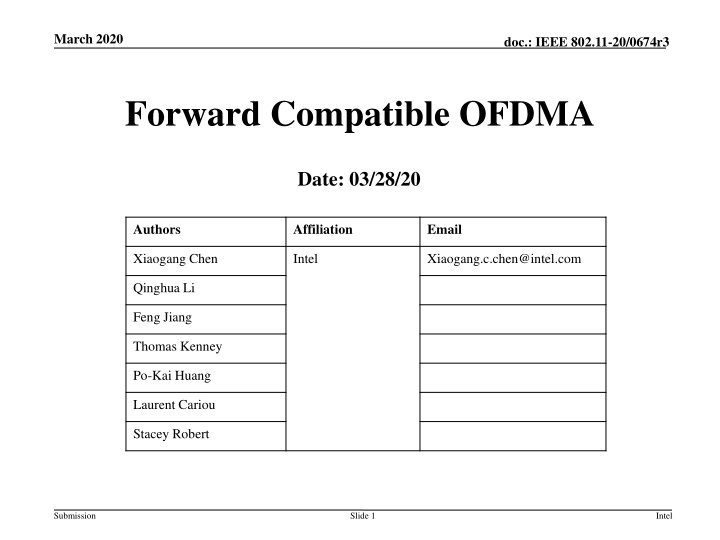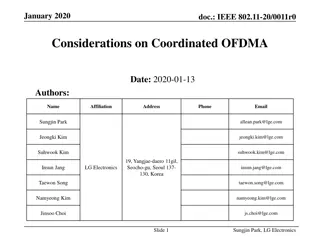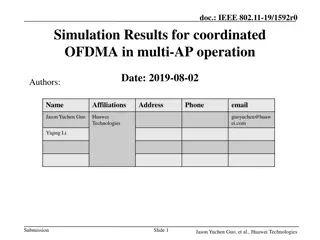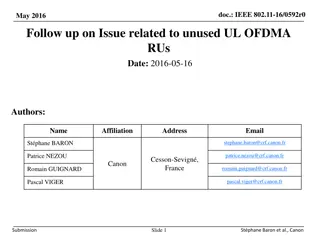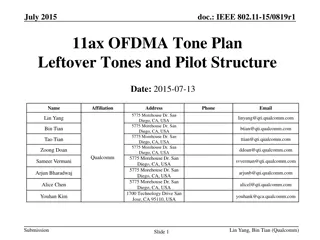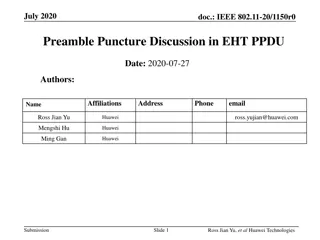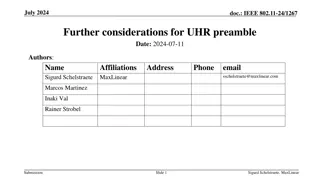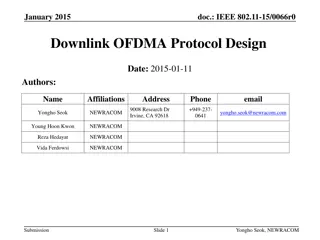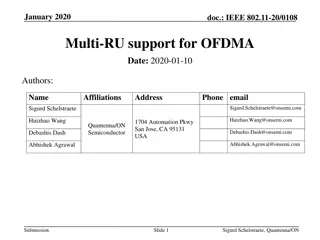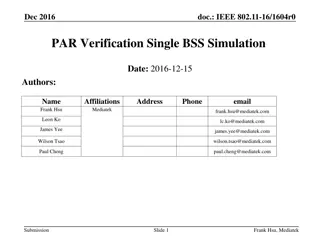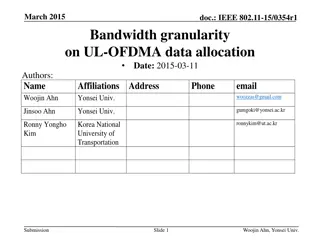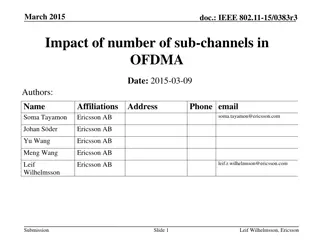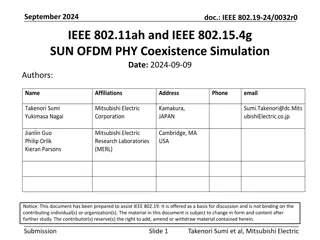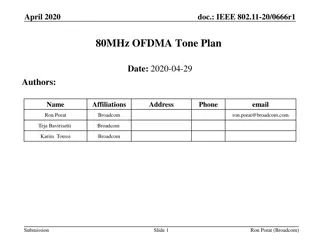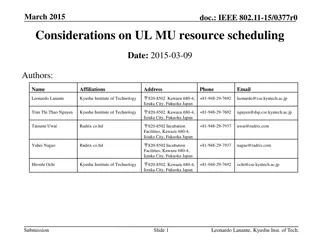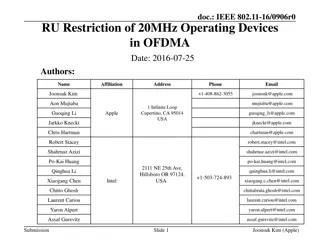IEEE 802.11-20/0674r3 Forward Compatible OFDMA Overview
This document presents the concept of forward-compatible OFDMA in IEEE 802.11-20/0674r3, enabling scheduling of different WiFi devices in one transmission. It discusses the motivations, design examples, and considerations for achieving compatibility, efficiency, and flexibility as WiFi technology evolves.
Download Presentation

Please find below an Image/Link to download the presentation.
The content on the website is provided AS IS for your information and personal use only. It may not be sold, licensed, or shared on other websites without obtaining consent from the author.If you encounter any issues during the download, it is possible that the publisher has removed the file from their server.
You are allowed to download the files provided on this website for personal or commercial use, subject to the condition that they are used lawfully. All files are the property of their respective owners.
The content on the website is provided AS IS for your information and personal use only. It may not be sold, licensed, or shared on other websites without obtaining consent from the author.
E N D
Presentation Transcript
March 2020 doc.: IEEE 802.11-20/0674r3 Forward Compatible OFDMA Date: 03/28/20 Authors Affiliation Email Xiaogang Chen Intel Xiaogang.c.chen@intel.com Qinghua Li Feng Jiang Thomas Kenney Po-Kai Huang Laurent Cariou Stacey Robert Submission Slide 1 Intel
March 2020 doc.: IEEE 802.11-20/0674r3 Outline Background of theforward compatible OFDMA; Design examples; Summary. Submission Slide 2 Intel
March 2020 doc.: IEEE 802.11-20/0674r3 Forward compatible OFDMA (1/2) Concept: Enable the STAs of different WiFi amendments (WiFi 7/8/ STAs) be scheduled in one transmission. One transmission could be One PPDU or Multiple orthogonal PPDUs. Motivations: A large number of legacy WiFi devices will coexist with new WiFi devices for a long time; A 320MHz capable AP may serve several 80MHz capable clients each of which is from the same or different WiFi amendments. Improves the scheduling flexibility and efficiency as WiFi evolves. Submission Slide 3 Intel
March 2020 doc.: IEEE 802.11-20/0674r3 Forward compatible OFDMA (2/2) Forward compatible: enable multiplexing of EHT STA with EHT+ STA PHY requirements: Consistent tone spacing in different WiFi amendments; Preamble design support. MAC requirement: Enhanced Trigger/announcement frame. How about backward compatible? I.e. Enable multiplexing of HE STA with EHT STA in one transmission. Both HE and EHT technologies are on the table and ready for design; Backward compatible can also be considered if a simple solution is feasible; Mustbe transparent to WiFi 6 STA. Submission Slide 4 Intel
March 2020 doc.: IEEE 802.11-20/0674r3 Example of the MAC Protocol Downlink Announcement frame Move EHT and EHT+ STA to non-primary 80 for the succeeding Tx/Rx; HE STA stay on the P80 (Transparent to HE STA). EHT and EHT+ STA move back to P80 after Tx/Rx. DL announcement frame move STAs to Non-primary 80MHz for succeeding Tx/Rx AP P80 HE STA HE PPDU After reception: Transparent to HE STA EHT STA S80 Move back to P80 After reception: Move to S80 for Tx/Rx for EHT STA EHT PPDU Move back to P80 S160 11bX STA After reception: Move to S160 for Tx/Rx for 11bx STA 11bx PPDU Submission Slide 5 Intel
March 2020 doc.: IEEE 802.11-20/0674r3 Considerations of the PHY Protocols Preamble Data HE clients always camp on P80 and fully reuse the HE processing flow; Transparent to HE STA. EHT clients understand the new structure, and will process the EHT portion accordingly; Details will be defined in TGbe. Future generation (e.g. 11bx) STAs understand both legacy portions and 11bx portion. They will process their own portion correctly. HE_STA1 80MHz STF/LTF Pre-HE HE_STA2 80MHz STF/LTF Pre-EHT EHT_STA1 160MHz STF/LTF Pre-11bx 11bx_STA1 Submission Slide 6 Intel
March 2020 doc.: IEEE 802.11-20/0674r3 Considerations of the PHY Protocols (Cont d) All proposals below in IEEE are useful tools to support mixing WiFi amendments in one transmission: Per 80MHz variable U-SIG; Per 80MHz variable EHT-SIG; Per 80MHz puncturing indication; Symbol alignment between 80MHz segments. Guarantee the orthogonality of the transmissions from different WiFi amendments. Protocol-wise, forward compatible OFDMA is well backed up by the proposals in IEEE. May not need to initiate new preamble related design other than the ones we already have; Details need to be polished and not the scope of this contribution. Submission Slide 7 Intel
March 2020 doc.: IEEE 802.11-20/0674r3 Summary Enable multiple WiFi amendments in one transmission with OFDMA could be an useful feature as WiFi evolving; Propose to support this feature in EHT. The current protocols TGbe developed in IEEE paved the path for this feature already. Not much new protocol are required. Submission Slide 8 Intel
March 2020 doc.: IEEE 802.11-20/0674r3 SP Do you agree that 11be support the design of allowing multiplexing STAs of different amendments in one transmission with OFDMA using frequency domain A- PPDU? STAs of different amendments may include HE, EHT STA post-EHT STA is TBD; The BW allocated to different STAs that can be mixed in one transmission is TBD. This feature is targeted for R2. Submission Slide 9 Intel
